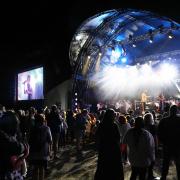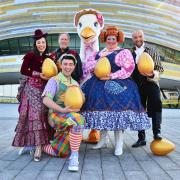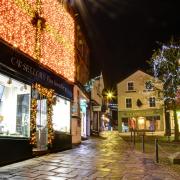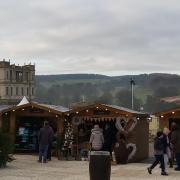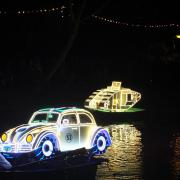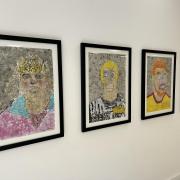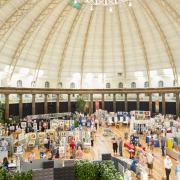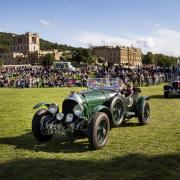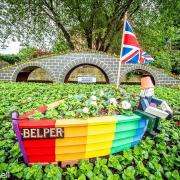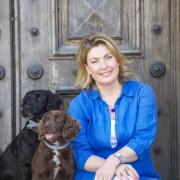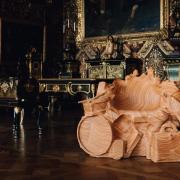This year it is 120 years since Queen Victoria gave Royal School for the Deaf Derby its royal status. While the school has changed enormously since this time, its ethos remains very much the same. Sarah Newton reports

Most people from Derby will recognise the green cast-iron box with a gold embossed stag, which stands on the pavement of Friar Gate. Some will know that it is a transformer box which once supplied electricity to the trams which ran up and down Ashbourne Road.
But for a handful of deaf people the box has a very poignant and emotional significance. For it stood opposite the original home of the Royal School for the Deaf Derby and was the place where parents waited in the hope of catching a brief glimpse of their children.
For parents were not allowed to visit their offspring, who were allowed home only three times a year, unless there were very special circumstances. So, pupils would stand at the window and wave to their parents, a moment in time too heart-wrenching to imagine.
Many of these students had no idea they were to be left at the school until they arrived at its enormous and imposing entrance. And once inside the ornate doors, which were carved by an unknown deaf sculptor, they found themselves in a stately reception area filled with stuffed birds in glass cases.

Deaf historian Wendy Daunt said: ‘I can’t imagine how small children would have felt coming into this dark and imposing hall, through the intimidating front door.
‘They had no idea what to expect and had not been prepared for life at the school, in fact some did not even know they would be staying there. Seeing the birds staring down at them from their glass prisons must have been terrifying.’
Of course, the school, which has been open since 1894, has changed enormously since these times. The building is long gone, along with the original name – the Midlands Institute for the Deaf and Dumb.
Today the school is attended by 126 children and young people aged between three and 19. The site in Ashbourne Road is colourful, friendly and welcoming, with an impressive water feature greeting visitors to the school.

The school prides itself on being warm and inclusive and provides both day and week-long residential places for deaf students, who come from all over the country to receive their education.
Staff encourage children to have a strong deaf identity and a clear sense of belonging. Not all deaf children have a sense of which world they belong in, so the school works hard to help them to believe they can function in a hearing world and feel equipped to manage the challenges ahead.
British Sign Language and English are taught equally so that every child can access the curriculum regardless of age, ability or communication mode and the school fosters a stronger sense of community so that no one feels isolated or left out.
It is hard to believe now, seeing the school with its science labs, sports hall, outdoor gym equipment and recently refurbished residential areas, that deaf people were once so ill-treated and misunderstood by society that education was considered unnecessary.

At one stage even the Church held the belief that a child’s deafness was a result of God punishing the sins of the parents. As a result, deaf people were excluded from taking part in religious worship and they were given the status of imbeciles – incapable of education.
Because of this prejudiced view, for many years deaf people were considered incapable of making a will or of inheriting property from their families.
The deaf were effectively cut off; they were deprived of literacy and education and all knowledge of the world. They were forced to do the most menial work; living alone, often close to destitution. In short, the lot of the deaf was manifestly dreadful.
But everything changed for deaf people in Derby when Dr William Roe, a successful harness maker, made friends with a deaf employee called Jack. Realising that Bible classes were inaccessible to deaf people Dr Roe started teaching Jack and his friends in his spare time.
This led Dr Roe, and his good friend Sir Henry Bemrose, to begin fund-raising for a school for deaf children and the Friar Gate site opened in 1897 after a £12,000 fund-raising push.
Dr Roe’s aim for the school was to make the children into adults who could make a living and fend for themselves, becoming a functioning part of society, rather than a burden to it. Pupils were taught English, maths, speech and physical education, as well as skills for a trade. For boys, this included instruction in carpentry, metalwork, boot repairing and gardening and girls learned cookery, sewing and laundry work.
Dr Roe’s wife Lydia was a pioneer in her own right becoming the first woman to teach deaf pupils in England and money from her will paid for the school’s accommodation block to be built.
The school was absolutely ground-breaking and to this day Dr Roe’s memory lives on: his portrait hangs in reception and the school’s mascot, a cuddly mouse, was named Roe by the children.
Mrs Dawes added: ‘At one time people thought that deaf people couldn’t be educated; that it was impossible for them to learn anything. Thankfully Dr William Roe and Lydia were among the first to realise that deafness was a communication barrier, but not a barrier to learning.
‘Deaf people deserved an education just as much as the next person, if not more so – for an education meant they were learning to communicate for the very first time.
‘It was through Dr Roe’s sheer faith and determination that he got the school. He had to attack a thick forest of ignorance all about him and find his way into the hearts of the wealthy businessmen of Derby, many of whom became real benefactors of the school.
‘The school has been life-changing for generations of deaf children in Derby and it’s all thanks to one man and his dogged determination to make life better for deaf people. His name still brings a smile to the faces of all our pupils.’
In 1897, the school gained its royal status when Queen Victoria bestowed the title as part of her Diamond Jubilee celebrations. Since then the school has welcomed several members of the Royal family, including Princess Margaret, Sarah, Duchess of York and, most recently, the Queen herself.
Over the years the school has naturally evolved, although it continues to offer the highest standard of teaching and the pioneering pastoral care which William and Lydia Roe pioneered.
Today teaching methods are no longer by rote learning but by empowering the pupil to play an active role in their education. Lessons usually involve small groups of five or six and involve considerable interaction with the teacher.
Subjects taught at the school, which is now the biggest employer of deaf people in the East Midlands, have also changed emphasis over the years. It offers a broad and balanced curriculum, which allows students to study for a wide variety of GCSEs and other external qualifications.
And where the school’s catchment was once very local, it now takes pupils from as far afield as Scotland and Wales.
But what remains unchanged is the unstinting determination of staff to improve the lives of the deaf children in their care; by educating them, caring for them and empowering them with the skills to live a productive and independent life.
Head teacher Helen Shepherd said: ‘Hearing people often think of deafness as simply an inability to hear. But being deaf is more than just whether a person can hear or not – it’s about being part of a community with its own history, values, and culture.
‘This is why deaf history and culture is a very important part of our curriculum today. From the outset, the school was extremely progressive and today we encourage pupils to learn about the school’s fine history and to be proud of it.
‘Most deaf people don’t view their deafness as a disability or as a problem that should be fixed. For many of them, it’s a natural part of a cultural experience that they share with friends, both deaf and hearing. We encourage our pupils to be proud of themselves and we invite deaf role models into school as often as possible.
‘I feel absolutely confident that Dr Roe would be amazed and proud if he could look around the school today. His legacy has grown and thrived and today the school is a place I am truly proud to work at.’






